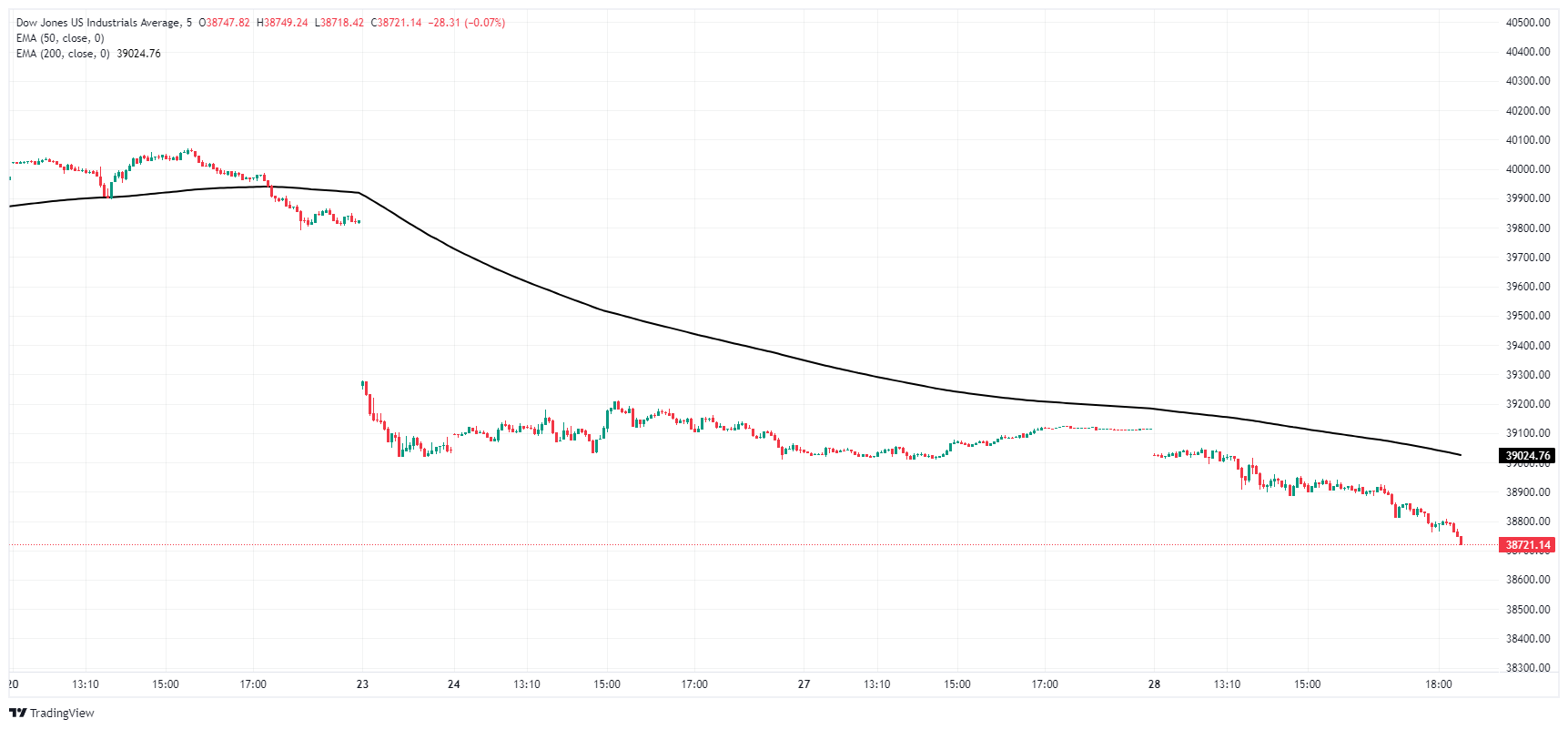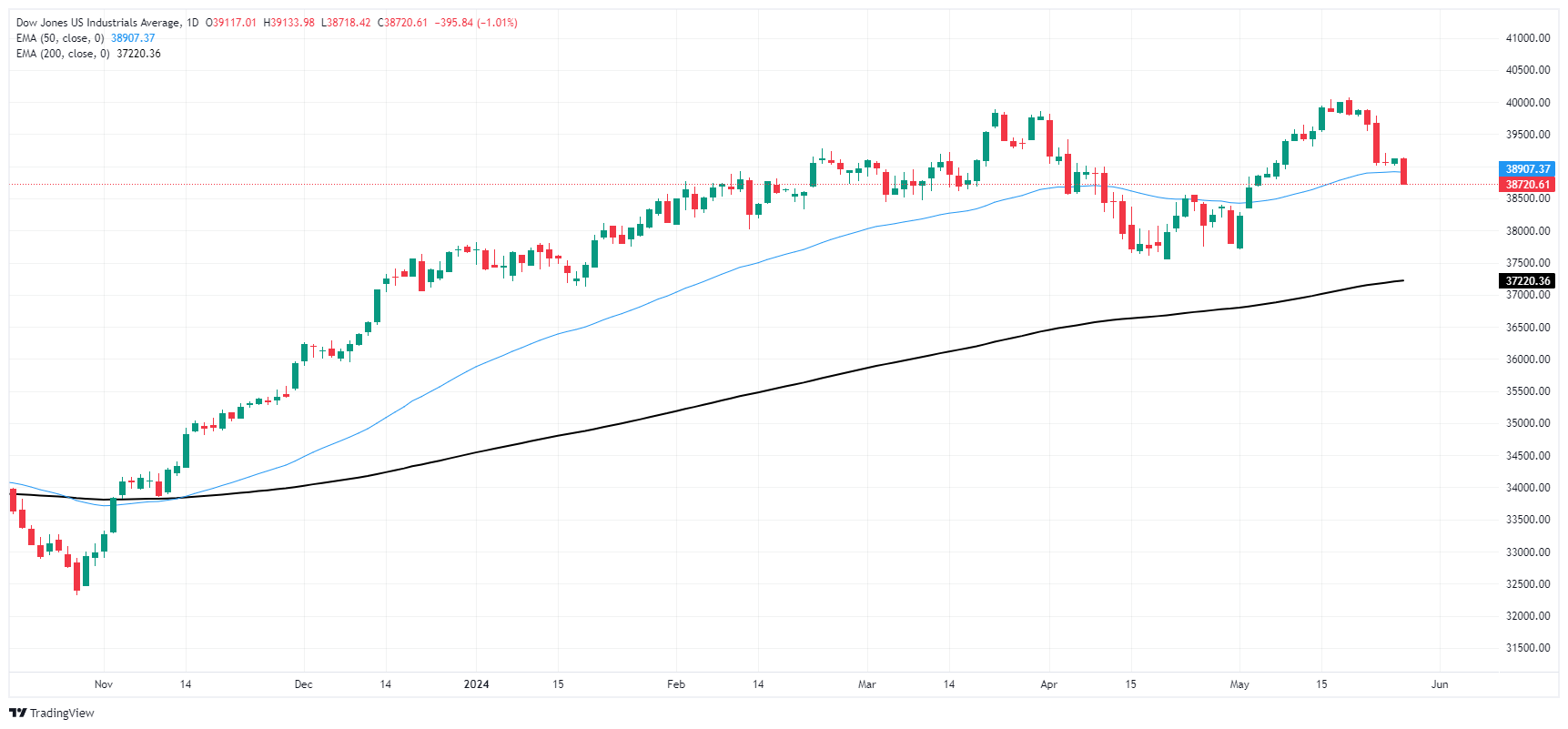- Phân tích
- Tin tức và các công cụ
- Tin tức thị trường
- Dow Jones Industrial Average backslides on Tuesday, dragged down by health sector
Dow Jones Industrial Average backslides on Tuesday, dragged down by health sector
- Dow Jones gets dragged down by declines in healthcare and biotech.
- Equities rebalancing after US markets return after holiday.
- Investors on the lookout for signs of rate cuts from cautious Fed.
The Dow Jones Industrial Average (DJIA) shed weight on Tuesday after US markets returned to action following an extended holiday weekend. The Dow Jones drew the short straw of the major US indexes, tumbling three-quarters of a percent as investors pull back on healthcare services and biotech stocks listed on the Dow Jones.
All four of the health-related stocks listed on the Dow Jones are down steeply on Tuesday, dragging the major equity index into the red. The Conference Board’s consumer confidence and inflation outlook both accelerated in May, highlighting the difficulties lying ahead for the Federal Reserve (Fed) to deliver rate cuts as fast and as furious as investors continue to hope for. With economic activity continuing to flaunt broad-market forecasts for a downturn that has yet to materialize, and consumer fears of inflation anchoring realized inflation higher, the Fed’s options for trimming interest rates have been hobbled looking forward.
The CB’s Consumer Confidence Index rose to 102 on Tuesday, up from the revised previous of 97.5, and rising above the forecast 96. CB consumer 12-month inflation expectations also rose to 5.4%, with the share of those expecting higher rates rising to 56.2%.
Investors will be looking ahead to Thursday’s US Annualized Q1 Gross Domestic Product (GDP), which is expected to ease to 1.3% versus the previous 1.6%. Friday’s Core US Personal Consumption Expenditure (PCE) inflation is forecast to hold at 0.3% MoM in April.
Dow Jones news
The Dow Jones is sharply lower compared to its peer US indexes, shedding over 300 points as healthcare stocks send the equity board into its lowest since the beginning of the month. Over two-thirds of the DJIA are in the red on Tuesday, with losses being led by three of the four listed health-associated securities.
Merck & Co Inc. (MRK) is down -2.7% at $126.00 per share, closely followed by biotech firm Amgen Inc. (AMGN), which shed -7 points, falling -2.33% and dropping below $300.00 per share for the first time since the start of the month. Johnson & Johnson (JNJ) also fell -1.81% to $144.31 per share.
Dow Jones technical outlook
The Dow Jones Industrial Average fell back below 38,800.00 on Tuesday as the index sheds over 300 points and shows no signs of slowing. The index has tumbled nearly nine-tenths of a percent on the day, and the index is now down 3.5% from record highs just above 40,000.00.
Despite trading deep into bull country above the 200-day Exponential Moving Average (EMA) at 37,220.31, the Dow Jones is poised for further technical downside as the index tumbles through the 50-day EMA at 38,907.10.
Dow Jones five minute chart
Dow Jones daily chart
Dow Jones FAQs
The Dow Jones Industrial Average, one of the oldest stock market indices in the world, is compiled of the 30 most traded stocks in the US. The index is price-weighted rather than weighted by capitalization. It is calculated by summing the prices of the constituent stocks and dividing them by a factor, currently 0.152. The index was founded by Charles Dow, who also founded the Wall Street Journal. In later years it has been criticized for not being broadly representative enough because it only tracks 30 conglomerates, unlike broader indices such as the S&P 500.
Many different factors drive the Dow Jones Industrial Average (DJIA). The aggregate performance of the component companies revealed in quarterly company earnings reports is the main one. US and global macroeconomic data also contributes as it impacts on investor sentiment. The level of interest rates, set by the Federal Reserve (Fed), also influences the DJIA as it affects the cost of credit, on which many corporations are heavily reliant. Therefore, inflation can be a major driver as well as other metrics which impact the Fed decisions.
Dow Theory is a method for identifying the primary trend of the stock market developed by Charles Dow. A key step is to compare the direction of the Dow Jones Industrial Average (DJIA) and the Dow Jones Transportation Average (DJTA) and only follow trends where both are moving in the same direction. Volume is a confirmatory criteria. The theory uses elements of peak and trough analysis. Dow’s theory posits three trend phases: accumulation, when smart money starts buying or selling; public participation, when the wider public joins in; and distribution, when the smart money exits.
There are a number of ways to trade the DJIA. One is to use ETFs which allow investors to trade the DJIA as a single security, rather than having to buy shares in all 30 constituent companies. A leading example is the SPDR Dow Jones Industrial Average ETF (DIA). DJIA futures contracts enable traders to speculate on the future value of the index and Options provide the right, but not the obligation, to buy or sell the index at a predetermined price in the future. Mutual funds enable investors to buy a share of a diversified portfolio of DJIA stocks thus providing exposure to the overall index.
© 2000-2024. Bản quyền Teletrade.
Trang web này được quản lý bởi Teletrade D.J. LLC 2351 LLC 2022 (Euro House, Richmond Hill Road, Kingstown, VC0100, St. Vincent and the Grenadines).
Thông tin trên trang web không phải là cơ sở để đưa ra quyết định đầu tư và chỉ được cung cấp cho mục đích làm quen.
Giao dịch trên thị trường tài chính (đặc biệt là giao dịch sử dụng các công cụ biên) mở ra những cơ hội lớn và tạo điều kiện cho các nhà đầu tư sẵn sàng mạo hiểm để thu lợi nhuận, tuy nhiên nó mang trong mình nguy cơ rủi ro khá cao. Chính vì vậy trước khi tiến hành giao dịch cần phải xem xét mọi mặt vấn đề chấp nhận tiến hành giao dịch cụ thể xét theo quan điểm của nguồn lực tài chính sẵn có và mức độ am hiểu thị trường tài chính.
Sử dụng thông tin: sử dụng toàn bộ hay riêng biệt các dữ liệu trên trang web của công ty TeleTrade như một nguồn cung cấp thông tin nhất định. Việc sử dụng tư liệu từ trang web cần kèm theo liên kết đến trang teletrade.vn. Việc tự động thu thập số liệu cũng như thông tin từ trang web TeleTrade đều không được phép.
Xin vui lòng liên hệ với pr@teletrade.global nếu có câu hỏi.















